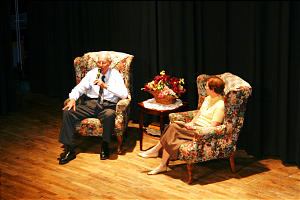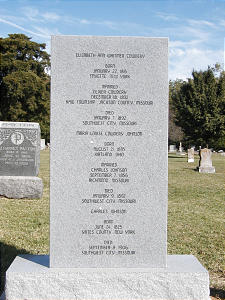Oliver Cowdery Commemorative Events and Symposium
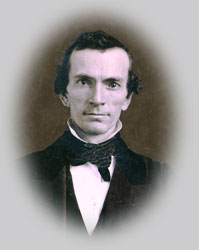
October 3, 2006 marked the 200th anniversary of the birth of the second elder of the Church, Oliver Cowdery. Oliver served as scribe for the majority of the translation of the Book of Mormon.
Oliver was also present with the Prophet Joseph Smith at the restoration of the Aaronic and Melchezidek Priesthoods, was the first person baptized with authority in this dispensation, and served as the Assistant President of the Church. He was also one of the Three Witnesses of the Book of Mormon and was present when the keys of this dispensation were bestowed upon him and the Prophet Joseph Smith by the Savior, Moses, Elias, and Elijah in the Kirtland Temple on April 3, 1836.
Although Oliver spent ten years out of the Church, he returned to the Church in 1848 and died in full-fellowship in 1850.
Several events in connection with Oliver’s birth were sponsored by the Mormon Historic Sites Foundation. First, on September 23, 2006, a commemoration near the birthplace of Oliver Cowdery in Wells, Vermont was held in which Mormon Historic Sites Foundation presented Wells Village a portrait of Oliver by Ken Corbett based on the recently discovered daguerreotype of Oliver found in the Library of Congress.
Next, events took place on October 6-8, 2006 in Richmond, Missouri, where Oliver passed away in 1850. The commemoration activities included the first ever Whitmer family reunion. Oliver’s wife, Elizabeth Ann Whitmer, was the daughter of early Church leader Peter Whitmer, Sr. A memorial to Elizabeth Ann and others was dedicated in Southwest City, Missouri was among several activities. MSHF presented the City of Richmond with a portrait of Oliver, similar to one presented in Wells, Vermont.
Finally, the Mormon Historic Sites Foundation and the BYU Religious Studies Center co-sponsored a symposium focused on the life and mission of Oliver Cowdery entitled “Oliver Cowdery: Restoration Witness, Second Elder.”
The symposium was held at Brigham Young University and included topics of interest related to Oliver. Speakers included Richard L. Anderson, Susan Easton Black, Steven C. Harper, Jeffrey N. Walker, John W. (Jack) Welch and several others. Additionally, Patrick A. Bishop discussed the discovery and identification of a new daguerreotype of Oliver. View the entire schedule of speakers here.
Articles & Resources
Whitmer clan honors ancestors
Author(s): Sheila Bridges
Published in: LDS Church News
Publication Date: October 14, 2006
Published October 14, 2006. Reprinted with permission from the LDS Church News a division of the Deseret Morning News.
Whitmer clan honors ancestors
Reunion includes descendants of Oliver Cowdery and Hiram Page
Sheila Bridges, Liberty Missouri Stake director of public affairs
RICHMOND, Mo. In conjunction with the bicentennial of Oliver Cowdery’s Oct. 3, 1806, birth, the Liberty Missouri Stake and the Mormon Historic Sites Foundation co-sponsored a Whitmer family celebration-reunion Oct. 6-7, in this city where the grave sites of Oliver and fellow Book of Mormon witness David Whitmer are located.
Oliver was married to Elizabeth Ann Whitmer, the youngest member of the Whitmer family, so he was a brother-in-law to David. Oliver, David and Martin Harris were the Three Witnesses to the Book of Mormon. By virtue of his marriage, Oliver is also the brother-in-law of the Whitmers who were among the Eight Witnesses to the Book of Mormon: Christian, Jacob, Peter Jr. and John.
Several descendants of the Hiram Page (another of the Eight Witnesses) and Whitmer families warmly greeted one another, some relatives connecting for the first time, as they gathered at the Richmond Historic Farris Theater to commemorate Oliver’s 200th birthday anniversary.
The theater itself has a place in Church history as the location where, in 1911, the Mormon Tabernacle Choir performed for the dedication ceremony for a monument to the Three Witnesses in the cemetery at Richmond.
Frank Outersky, executive director of the theater, was master of ceremonies for the program. Lorene Pollard, great-great-granddaughter of John Whitmer, shared family stories reflecting on the home sites in Richmond and Far West.
Gloria Simpson, a descendant in the Hiram and Catherine Whitmer Page lines, was unable to attend due to an accident, but an e-mail she sent was read by President Sean Foley of the Church’s Richmond Branch. She has expanded the family genealogy online, inviting her family members to add their personal histories.
Harold Barchers, third-great-grandson of Mary and Peter Whitmer Sr., said, “Go home and look in a mirror. You will be looking at what your ancestors looked like.” He shared stories of family traits that continue to be passed down.
Bonnie Page Damon, a descendant of the Hiram and Catherine Whitmer Page family, spoke of her love for family treasures and heirlooms and the closeness she feels to her ancestors through them. She told of a handmade cane chair, walking canes and a marble slab that had been part of an outdoor washstand at the family farm. The marble slab now rests inside her home and evokes family memories.
Larry C. Porter, professor emeritus of Church history and doctrine at BYU, was the keynote speaker. He assisted in finding the location of the Peter Whitmer Sr. cabin site in Fayette, N.Y., where Joseph Smith completed the translation of the Book of Mormon in late June 1829. It was in this cabin on April 6, 1830, that the Church was formally organized with a small congregation attending.
Brother Porter told of the cabin’s reconstruction over the original foundation and drew on journals, newspaper accounts and local history to describe the contributions of the Whitmer family, whom he called “a family of integrity.”
Alexander Baugh, professor of Church history at BYU and a member of the board of trustees of the historic sites foundation, spoke of Oliver Cowdery and then presented a portrait of Oliver to Richmond Mayor Tom Morman. The portrait will be displayed in the Ray County Courthouse in Richmond.
The day after the reunion, Brother Baugh and about 80 members of the Rogers Arkansas Stake journeyed to Southwest City, Mo., just over the border from Arkansas. There, they held a service to dedicate a monument at the grave site of Oliver Cowdery’s wife, Elizabeth Ann Whitmer Cowdery, and their only daughter to survive from childhood, Maria Louise Cowdery Johnson. The marker also notes the nearby grave site of Charles Johnson, husband of Maria Louise.
Brother Baugh said that about six years after the death of her father in Richmond, Maria Louise married Charles Johnson. Her mother, Elizabeth Ann, continued to live with her daughter and her daughter’s husband. They ended up in Southwest City, where Elizabeth Ann died Jan. 7, 1892, and her daughter died two days later. Charles died in 1906.
“Really, nothing had been done for the acknowledgment of these graves down in the middle of nowhere,” Brother Baugh said, explaining why the Mormon Historic Sites Foundation desired that the service be conducted.
President David Stout of the Rogers Missouri Stake, a descendant of Church history figure Hosea Stout, dedicated the monument. Brother Baugh asked President Stout to provide the priesthood ordinance of dedication for both graves, surmising that this probably had never been done.
Elizabeth Ann had always remained in the Church, even during the years that Oliver was excommunicated. In fact, following his rebaptism at Kanesville, Iowa, in 1848, Oliver had intended to bring his family west to join the Latter-day Saints in Utah, but failing health precluded the journey, and he died while staying with his Whitmer relatives in Richmond. Contributing: R. Scott Lloyd
Oliver Cowdery
Author(s): R. Scott Lloyd
Published in: LDS Church News
Publication Date: September 30, 2006
Published September 30, 2006. Reprinted with permission from the LDS Church News a division of the Deseret Morning News.
Oliver Cowdery
200th birthday of scribe, witness of Book of Mormon
R. Scott Lloyd, Deseret Morning News
WELLS, Vt. It was 200 years ago on Oct. 3 that Oliver Cowdery, one of the three special witnesses to the
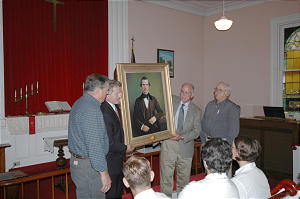
Book of Mormon, was born in this New England town. Local Church members and townspeople marked the occasion Sept. 23 by gathering in a Methodist church where they heard addresses from a BYU Church history professor and from the president of the Montpelier Vermont Stake.
The celebration was to have occurred on the town green, but a rain shower made it necessary to meet in the Methodist church, where the Rev. David Adams, pastor of the church, and Ron Bremmer, chairman of the town select board (comparable to a mayor) were in attendance.
“In Vermont, Oliver learned the three Rs of reading, ‘riting and ‘rithmatic; when he left, he would learn about another three Rs: restoration, revelation and reconciliation,” said Fred E. Woods, professor of Church history and doctrine, of Brother Cowdery, whose joint statement with his colleagues David Whitmer and Martin Harris appears in the preface of the Book of Mormon affirming the divine vision in which an angel showed them the Book of Mormon plates
Oliver was the “second elder” of the restored Church (see Doctrine and Covenants 20:2) and one of the six founding members of the Church, Brother Woods noted. “Oliver served as Joseph Smith’s scribe in writing the Book of Mormon, which is now considered to be one of the most influential books in America. Thus, today we commemorate an individual who has influenced not only Mormon history and theology, but has also shaped American history and religion.”
Brother Woods traced events of Oliver’s life, including his boarding with the Smith family as a schoolteacher in 1828-29 in Manchester Township, N.Y., and his subsequent meeting with the Prophet; his presence when the Aaronic and Melchizedek priesthood were restored by divine messengers; and his instrumentality in the translation and publication of the Book of Mormon.
Citing Doctrine and Covenants 6, Brother Woods noted that Oliver was counseled to “seek not for riches, but for wisdom” (6:7), that he would be “the means of doing much good” (6:8), and that his inquiring mind led to revelation (6:14-17, 21-24).
“Oliver struggled with the universal sin of pride, as we all do to one degree or another,” Brother Woods said. “He was excommunicated in April 1838 for a variety of issues, which included not supporting the government of the Church. However, G. Homer Durham writes, ‘What may have been false accusations, mingled with misunderstandings growing from the sale of land, finally led to his refusal to appear before a Church council.’ Those who brought the charges all lost their membership and later became enemies of the Church.”
In the subsequent decade, Oliver practiced law, primarily in Tiffin, Ohio, all the while never denying his written testimony of the Book of Mormon, despite, on one occasion, being confronted over the matter in a courtroom by an opposing attorney, Brother Woods recounted.
“During a six-year period (1842-48), Phineas Young, brother of Brigham Young and brother-in-law of Cowdery (Phineas being married to Oliver’s half-sister Lucy) continually wrote and paid visits to Oliver,” Brother Woods said. “At the same time, Church leaders were feeling after Oliver. For example, Willard Richards, who kept the Prophet Joseph Smith’s journal, was directed by Joseph in the spring of 1843 to ‘write to Oliver Cowdery and ask him if he has not eaten husks long enough, if he is not most ready to return.’ The Twelve sent a letter to Oliver with an invitation to return to the fold which, among other things, stated, “Your brethren are ready to receive you…. Your dwelling place you know ought to be Zion.”‘
Oliver responded cordially but was not quite ready to reclaim his Church membership, as he felt the circumstances surrounding his excommunication had not been examined in their true light, Brother Woods commented.
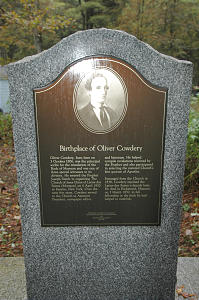
In October 1848, Phineas Young visited the Cowdery family at their home in Elkhorn, Wis., Brother Woods said. He escorted Oliver, his wife, and their only surviving child of six children to Kanesville, Iowa, to attend the local conference of the Church. There, Oliver addressed the gathering of nearly 2,000 people and requested membership in the Church. In subsequent weeks, he was received back into full fellowship and rebaptized on Nov. 12, 1848.
Desiring to join with the body of the Church in the Salt Lake Valley and launch a fruit-tree business, he first took his wife to visit with her family, the Whitmers, in Richmond, Mo. Failing health would not permit him to undertake the journey west, and he died on March 3, 1850. Brother Woods quoted Oliver’s brother-in-law, David Whitmer, as saying, “Oliver died the happiest man I ever saw. After shaking hands with the family and kissing his wife and daughter, he said, ‘Now I lay down for the last time; I am going to my Saviour’ and he died immediately with a smile on his face.”
President Michael D. Sessions of the Montpelier Vermont Stake said the Church “has deep foundational roots in the Green Mountain State of Vermont. A solid foundation must rest upon a rock, and with the granite of Vermont being covered by only a bit of shallow dirt, there’s plenty of place upon which God could build His latter-day Church.”
The Mormon Historic Sites Foundation is co-sponsoring two other Oliver Cowdery commemorative events. On Oct. 6-7, the Liberty Missouri Stake and descendants of Peter and Mary Whitmer will hold a Cowdery commemoration and Whitmer family reunion in Richmond, Mo. On Nov. 10, an Oliver Cowdery Symposium will be held in the BYU Conference Center in Provo, Utah, from noon to 5 p.m. The event is open to the public and free of charge.
"What Greater Witness can you have than from God?" A Look at the Undeviating Testimony of Oliver Cowdery including his Rebirth, Reconciliation and Return to Mormonism
Author(s): Fred E. Woods
Publication Date: September 23, 2006

